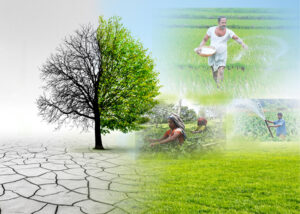Physical Address
23,24,25 & 26, 2nd Floor, Software Technology Park India, Opp: Garware Stadium,MIDC, Chikalthana, Aurangabad, Maharashtra – 431001 India
Physical Address
23,24,25 & 26, 2nd Floor, Software Technology Park India, Opp: Garware Stadium,MIDC, Chikalthana, Aurangabad, Maharashtra – 431001 India

CLAIM
The new weather patterns caused due to climate change in Sri Lanka have allowed the cultivation of many crops.
WHAT THEY SAY
For Sri Lanka, climate change is a blessing in disguise as many crops can be cultivated under the new weather patterns in different regions, and it’s ultimately profitable.
WHAT WE FOUND
We analysed how climate change has impacted a few food crops growing around the country to understand the problem better.
Rice cultivation
Rice cultivation is carried out in two seasons. During the Maha season (rainfed regime), water deficit generally presents negative factors in addition to maximum and minimum temperatures. Anuradhapura, in the dry zone, also shows a decrease in yield due to precipitation variables. The reason is the negative impacts of floods affecting lowland areas during the Maha season. During the Yala season (irrigated regime), precipitation shows an advantage in agriculture, while water deficit appears to be disadvantageous. This suggests that water scarcity can still lead to damage and yield losses during the Yala (drier) season. Hence, climate change negatively impacts the cultivation of rice.
chilli cultivation
Considering chilli cultivation, in the Yala season, Puttalam has shown significant improvement in the last 30 years, while in the other districts, this improvement was marked in the Maha season. Generally, all chilli-cultivated areas show improved harvest in both Yala and the Maha seasons. Therefore, it can be concluded that the chilli plant can adapt to climate change. In this case, temperature, rather than precipitation, is considered the primary determinant of crop yield. There is a significant decrease in output when the growth temperature increases. Drought conditions could also adversely affect the germination of seeds, with further adverse effects on crop growth and development. Due to the limited availability of water for irrigation, the cultivation of chilli is possible only in 16% of the potential arable area. Read more here, Archived.
Big onion
Big onion is cultivated mainly during the Yala season (supplementary irrigation). Maximum and minimum temperatures appear to impact positively on the yield production. Big onion is indeed a crop that benefits from heat and high insolation, ensuring its adaptation to climate change. Read more here,
Maize (Zea mays L.)
Impacts of climate change on maize (Zea mays L.) cultivation was researched with biophysical data from the department of agriculture (DOA) in Sri Lanka for six central maize-growing districts (Ampara, Anuradhapura, Badulla, Hambantota, Moneragala, and Kurunegala) from 1990 to 2010. When this data was analysed, it was evident that each 1°C rise in seasonal mean temperature reduced maize yield by about 5% during the time period. Overall, this research shows a reasonable correlation between district maize yield and seasonal climate in most of the districts within the maize belt of Sri Lanka. Refer to the article here Archived.
Tea
The amount of land devoted to tea, coconut, and rubber remained stable in the last forty years after independence. Tea has the highest demand among these three. Sri Lanka has a climate and varied elevation that allows the production of both Camellia sinensis var. assamica and Camellia sinensis var. Sinensis varieties. The humidity, cool temperature, and rainfall in the country’s central highlands provide a climate that favours the production of high-quality tea.
The weather dramatically influences tea yield, especially droughts, which cause irreparable losses because irrigation is seldom used on tea plantations. At the other extreme, heavy rains erode topsoil and wash away fertilisers and other chemicals. The recently published Sri Lanka country report on climate change reported that the island would experience extreme rainfall intensities and warmer temperatures due to climate change. The possibility of a 10% increase in the length of dry and wet seasons per year in the main plantation area was also indicated. Thus, drought damage and soil losses in tea production areas will increase in the years to come. An analysis of the results of field experiments with weather data shows that increases in temperature, soil moisture deficit, and saturation vapour pressure deficit in low elevations will adversely affect the growth and yield of tea. Reports have also shown that about 30 cm of soil has already been eroded from upcountry tea plantations. Refer to the article here Archived.
We discussed this claim with the department of agriculture, agro climatology, and climate change NRMC unit. They mentioned that there are more adverse effects on crops due to climate change, and considering this, the government is now moving on change in cropping times. A cultivation calendar has been introduced for this purpose. The crop calendar can be found here.
However, to cure this situation and prevent crop damage due to climate change, the government is conducted ongoing research projects on shifting crops and crop improvements. Moreover, the NRMC unit has mentioned that there were more adverse effects than benefits of crop cultivation due to climate change.
Conclusion
Accordingly, crop cultivation in Sri Lanka is vulnerable to predicted climate changes and, subsequently, more significant economic, social, and environmental problems. Our fact-check was carried out among major crop varieties of Sri Lanka, showing that climate change has more harmful effects on those crops than benefits. Though the statement refers to an improvement in agriculture, we cannot expect positive outcomes from the climate crisis.